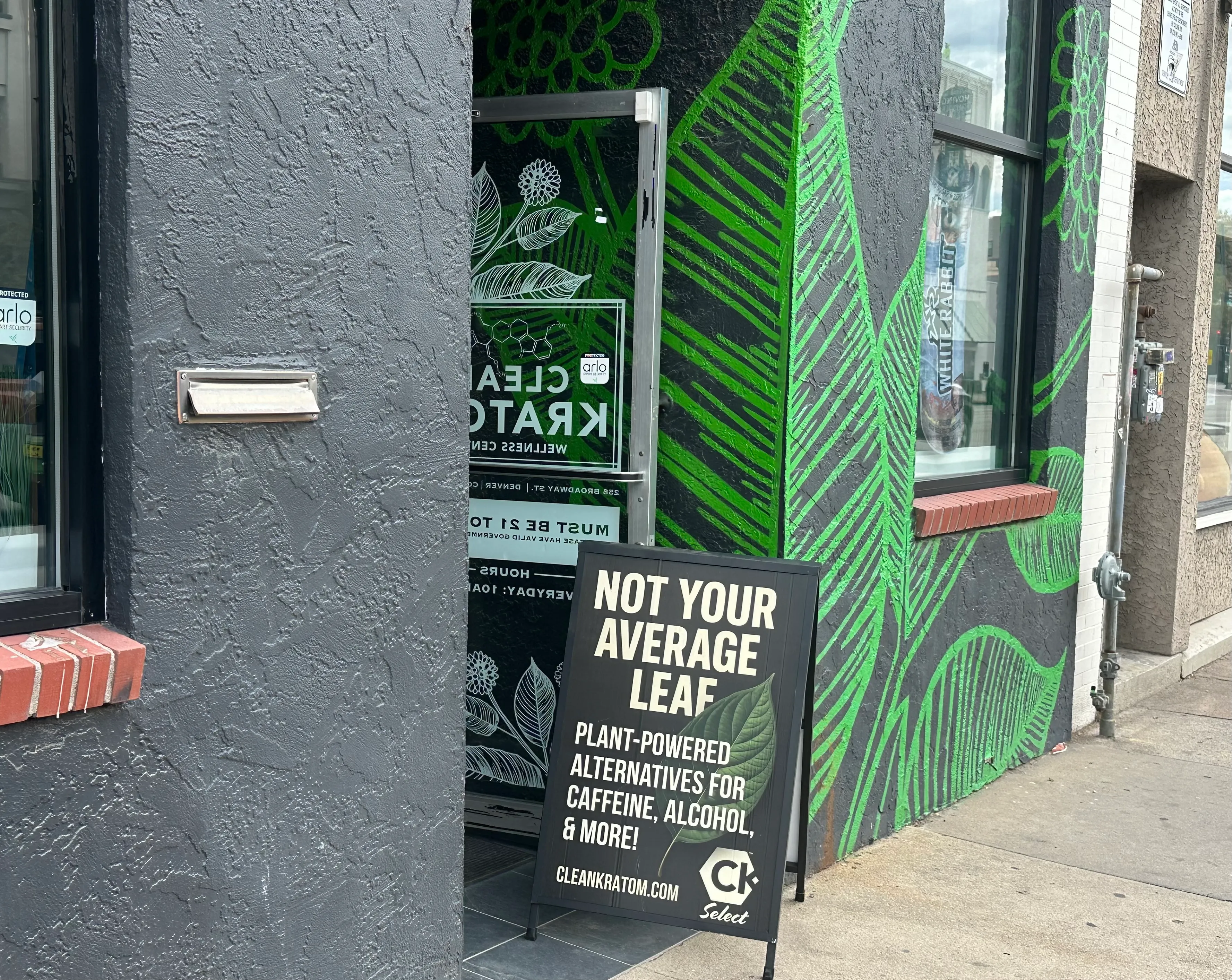
David is a white-collar professional in his early fifties who lived in Denver before relocating to New Mexico. He began using kratom in its powdered form in the fall of 2018 to address post-traumatic stress disorder-induced insomnia. “I’d take kratom to calm down and be able to go back to sleep,” he says. “It was definitely beneficial, because it was both more effective than alcohol — which I’d been using off-and-on for the same purpose for more than a decade — and less harmful to my body.”
David says he didn’t use kratom every night at first, maybe twice a week on average, to get back to sleep. But eventually he started consuming the kratom powder — ground up leaves from the Southeast Asian tree called Mitragyna speciosa, often sold in vape shops and head shops — in the evenings to “decompress” after a stressful day.
“That quickly became a daily habit, and then a hardcore physical addiction,” David tells Westword. “It’s the same fucking cliche about addiction: You get to a point where the only way to get high is to take more, then you’re taking it not to feel sick. If you’ve been using it daily for more than six months, I’d say you’re going to go into withdrawal if you stop.”
Kratom advocates say the plant leaves are an effective alternative for individuals addicted to fentanyl and other opiates, and a valuable alternative to pharmaceutical drugs for treating pain and anxiety. Kratom leaves are usually ingested in a powdered form, sometimes in capsules, or as a tea. It’s sometimes packaged in ready-to-drink bottles as well.
Some users, like David, say kratom helped them move on from alcohol dependency, and they accept the catch. “I replaced one drug, alcohol, with another, but I think there’s no doubt I did less damage to my mind and body by being a kratom addict than continuing to be an alcoholic,” he contends.
Kratom isn’t accepted or even tolerated by many traditional medical institutes, such as the Mayo Clinic and the FDA, and can be physiologically addictive. But kratom is not a controlled substance, leaving its regulation up to local and state authorities. In the past few years, a slew of products have hit online markets and head shops, offering a concentrated form of the isolated effective metabolite found in kratom without the leaves. As products made with the plant and its extracts gain popularity, Colorado towns such as Monument, Greenwood Village and Parker have banned kratom from their municipalities entirely, and state lawmakers addressed the issue earlier this year.
David kicked his kratom addiction this past summer via a medically-assisted detox, which was “a very similar protocol to what they use for fentanyl and heroin,” he explains, using Suboxone, a key pharmaceutical tool in recovering from opiate addiction that combines buprenorphine and naloxone. He agreed to share his story in the wake of Colorado’s new regulatory framework for the controversial and commonly available drug. Senate Bill 25-072, also known as the Daniel Bregger Act, was signed by Governor Jared Polis in late May. The law was named after a young man who used a kratom product that had no ingredients listed and no warnings about combining the herbal product with sedatives. Bregger died in 2021 at the age of 33 after combining kratom with diphenhydramine, the active ingredient in the antihistamine Benadryl.
The Daniel Bregger Act didn’t ban kratom, but the law did implement new rules for Colorado kratom manufacturers and retailers, such as banning the sale of kratom to those under 21 and requiring kratom products be kept behind a counter like tobacco products. The new law also bans kratom vaporizers or any candy-like product that appears marketed to children, requires transparent labeling and dosing information, prohibits synthetic and semi-synthetic alkaloids in kratom, and caps the amount of the effective alkaloid in kratom, 7-hydroxymitragynine, or 7-OH, at 2 percent of the material.
Mitragynine and 7-OH in Kratom
The kratom plant contains mitragynine, which stimulates opioid receptors in the central nervous system, says David Kroll, a professor at the University of Colorado’s Skaggs School of Pharmacy and Pharmaceutical Sciences. Mitragynine is metabolized into 7-OH in our bodies, but converting mitragynine to 7-OH in the lab is relatively simple, Kroll points out. After the kratom industry learned this, the market was flooded with 7-OH products, which are often drinkable or sold as pressed tablets.
“You’re going from a morphine-type situation to a fentanyl-type situation,” is the analogy Kroll uses while describing the process of isolating 7-OH.
Joe Dvorzsak, who owns HQ Vape and Smoke Shop in Denver, recalls concentrated 7-OH products arriving on the market not long after Bregger’s death in 2021. “It quickly grew from there, because everyone started going bigger and cheaper,” Dvorzsak says, “which, you know, typically doesn’t end well.”
After the Daniel Bregger Act was implemented, Dvorszak dropped the products that weren’t compliant with the 2 percent limitation on 7-OH. He says his shop only stocks kratom products from two American manufacturers who’ve both been in business nearly a decade.
But it’s on shop proprietors, like Dvorszak, to know what they’re selling and consumers to know (or, at least, try to know) what they’re putting into their bodies, as there is still no rule mandating regulatory testing on kratom products in Colorado, though lawmakers have made attempts to codify testing and registration in past bills. Manufacturers and distributors are required to label ingredients, but unless the retailers are doing tests on the products themselves, consumers have only the labeling to trust for potency and dosing information.
In the midst of his kratom addiction, David encountered the 7-OH extracts, and he quickly felt their potency.
“It’s a similar difference to smoking cannabis versus doing one of those powerful cannabis extracts,” David says. According to David, he used 7-OH twice. The first time, he noted that the bottle had instructions not to drink more than a third of its contents — but he waffled.
“I was, like, ‘My tolerance is so high. Maybe I should just drink the whole bottle,’” he says. “And I didn’t. I’m so glad that I didn’t.”
David had been a daily powdered kratom user for five years when he drank the recommended third of a bottle of 7-OH; soon after, he “was not functional.”
“I was flattened in bed for ninety minutes. I don’t know what they’re doing with that shit; they turbocharge it. It’s an entirely different beast, and it scared me.” David says he only bought a bottle of 7-OH once more: before a business trip to Europe, where he wasn’t sure if he’d be able to procure kratom; he says he only put drops of the 7-OH in a glass of water rather than the recommended dose.
Kroll says that as a researcher, he doesn’t take a hard stance on the regulation of kratom, but “the concentrated individual constituents have more of a health risk than the powdered leaf product.” He’s also seeing newer second-generation compounds enter the market with the same chemical structure as 7-OH, but are still a couple of molecules off. “These don’t occur naturally,” he notes.
“A Compromised Piece of Legislation”
Kroll became interested in kratom when it was discovered that its alkaloids bind to an opioid receptor in a way that’s less intense than morphine, oxycodone or fentanyl. He saw a potential for safer opioids and, after writing about kratom for Forbes, received emails from hundreds of people telling him how much kratom had helped them. At the time, the DEA wanted to list kratom as a Schedule I substance, which would have outlawed kratom and deemed it of no medical value at the federal level. “That’s when I started writing,” he explains, “saying, ‘Wait a minute, you’ve made it harder to get prescription opioids. Now you’re taking away a milder opioid that people are successfully using on their own, and you’re going to make that illegal?’”
The DEA never classified kratom at the federal level, but state legislators took on kratom with the Daniel Bregger Act. The act was originally much more stringent, requiring kratom manufacturers to register with the state and to have FDA registration, with provisions for testing kratom products. But a series of disagreements and amendments watered the bill down.
“It’s a compromised piece of legislation,” Kroll says. “It doesn’t go as far as the DEA wants it to go, but I think it was a good-faith compromise by kratom lobbyists and people who’ve lost people to kratom products. While the legislation might not be as effective as you think it should be, it’s caused people to talk about it in a way that has raised awareness of the kratom issue.”
However, the FDA and DEA, as well as Colorado Attorney General Phil Weiser, aren’t dropping the topic. This summer, the FDA issued warning letters to seven companies marketing products with 7-OH. On August 13, Weiser issued a “public advisory” warning Coloradans about the new regulations under the Daniel Bregger Act. In September, a DEA agent stopped by Dvorzsak’s HQ Vape and Smoke Shop and dropped off a multi-page information packet about the dangers of kratom and 7-OH (the agent did not return Westword‘s request for comment).
While the onus is on manufacturers, distributers and retailers to comply with these regulations, consumers should be aware of potential dangers, too.
“Messing with concentrated potent compounds is a bad idea,” Kroll says. “There are better bad choices. If you want to try something out, try some kratom powder. But, honestly, don’t mess with the concentrates.”



